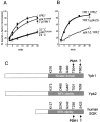The conserved Pkh-Ypk kinase cascade is required for endocytosis in yeast
- PMID: 11807089
- PMCID: PMC2199229
- DOI: 10.1083/jcb.200107135
The conserved Pkh-Ypk kinase cascade is required for endocytosis in yeast
Abstract
Internalization of activated signaling receptors by endocytosis is one way cells downregulate extracellular signals. Like many signaling receptors, the yeast alpha-factor pheromone receptor is downregulated by hyperphosphorylation, ubiquitination, and subsequent internalization and degradation in the lysosome-like vacuole. In a screen to detect proteins involved in ubiquitin-dependent receptor internalization, we identified the sphingoid base-regulated serine-threonine kinase Ypk1. Ypk1 is a homologue of the mammalian serum- and glucocorticoid-induced kinase, SGK, which can substitute for Ypk1 function in yeast. The kinase activity of Ypk1 is required for receptor endocytosis because mutations in two residues important for its catalytic activity cause a severe defect in alpha-factor internalization. Ypk1 is required for both receptor-mediated and fluid-phase endocytosis, and is not necessary for receptor phosphorylation or ubiquitination. Ypk1 itself is phosphorylated by Pkh kinases, homologues of mammalian PDK1. The threonine in Ypk1 that is phosphorylated by Pkh1 is required for efficient endocytosis, and pkh mutant cells are defective in alpha-factor internalization and fluid-phase endocytosis. These observations demonstrate that Ypk1 acts downstream of the Pkh kinases to control endocytosis by phosphorylating components of the endocytic machinery.
Figures





References
-
- Barbieri, M.A., A.D. Kohn, R.A. Roth, and P.D. Stahl. 1998. Protein kinase B/akt and Rab5 mediate Ras activation of endocytosis. J. Biol. Chem. 273:19367–19370. - PubMed
-
- Bauerfeind, R., K. Takei, and P. De Camilli. 1997. Amphiphysin I is associated with coated endocytic intermediates and undergoes stimulation-dependent dephosphorylation in nerve terminals. J. Biol. Chem. 272:30984–30992. - PubMed
-
- Casamayor, A., P.D. Torrance, T. Kobayashi, J. Thorner, and D.R. Alessi. 1999. Functional counterparts of mammalian protein kinases PDK1 and SGK in budding yeast. Curr. Biol. 9:186–197. - PubMed
-
- Chen, H., V.I. Slepnev, P.P. Di Fiore, and P. De Camilli. 1999. The interaction of epsin and Eps15 with the clathrin adaptor AP-2 is inhibited by mitotic phosphorylation and enhanced by stimulation-dependent dephosphorylation in nerve terminals. J. Biol. Chem. 274:3257–3260. - PubMed
-
- Chen, P., K.S. Lee, and D.E. Levin. 1993. A pair of putative protein kinase genes (YPK1 and YPK2) is required for cell growth in Saccharomyces cerevisiae. Mol. Gen. Genet. 236:443–447. - PubMed
Publication types
MeSH terms
Substances
Grants and funding
LinkOut - more resources
Full Text Sources
Molecular Biology Databases
Research Materials
Miscellaneous

